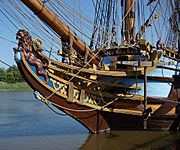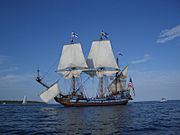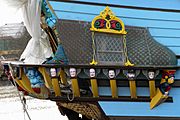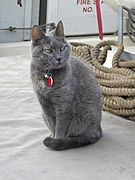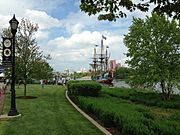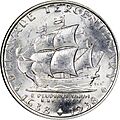Kalmar Nyckel facts for kids
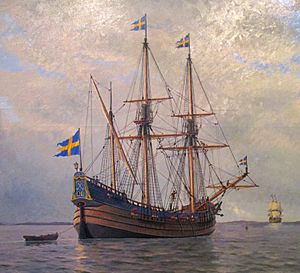
Calmare Nyckel oil painting by Jacob Hägg, 1922
|
|
Quick facts for kids History |
|
|---|---|
| Name | Kalmar Nyckel |
| Owner | The Ship Company (Skeppskompaniet) |
| Route | Gothenburg, Sweden — New Sweden, North America |
| Launched | c. 1625 |
| Acquired | 1629 |
| Status | Sold to Swedish Navy, 1644 |
| Commissioned | 1644 |
| Decommissioned | June 19, 1651 |
| Fate |
|
| General characteristics | |
| Type | Pinnace |
| Sail plan | Full-rigged ship |
| Crew | 40 sailors & 28 soldiers (in Naval service) |
| Armament |
|
The Kalmar Nyckel (meaning Key of Kalmar) was a famous Swedish ship. It carried Swedish settlers to North America in 1638. These settlers started the colony of New Sweden. The ship's name came from the Swedish city of Kalmar. The word nyckel means key in Swedish. The name also honored Kalmar Castle, a strong symbol of power during the time of the Swedish Empire. A new version of the ship was built and launched in Wilmington, Delaware, in 1997.
Contents
History of the Original Ship
The Kalmar Nyckel was built around 1625. It was a type of ship called a pinnace. A pinnace was a fast, light sailing ship. Its first name was Sleutel, which means key in Dutch. To tell it apart from other ships named Key, it was called after the city of Kalmar. The city bought the ship in 1629. It was part of a state-supported trading company called Skeppskompaniet. Later, the Swedish Navy bought the ship.
When Sweden decided to start a trading colony in the New World, the Kalmar Nyckel was chosen. It would carry settlers across the ocean. A smaller ship, the Fogel Grip (Griffin Bird), sailed with it.
First Voyage to North America
The two ships left Gothenburg, Sweden, in December 1637. Captain Jan Hindriksen van der Water was in charge. They ran into a big storm in the North Sea. They had to go to the Netherlands for repairs. They left again on New Year's Day in 1638. They arrived in North America in March 1638. The settlers built a fort where the city of Wilmington is today. They named it Fort Christina.
Later Voyages and Fate
The Kalmar Nyckel made a second trip on February 7, 1640. It arrived at Fort Christina on April 17. This trip brought more settlers to New Sweden. One of them was Reorus Torkillus, the first Lutheran church leader in New Sweden. The Kalmar Nyckel made four successful round trips from Sweden to North America. No other colonial ship made so many trips.
Between these long voyages, the Swedish Navy used the ship. It carried goods and messages. In 1651, the ship was sold to Dutch merchants. When the First Anglo-Dutch War started, it became a ship that protected fishing boats. On July 12, 1652, the ship was sunk. This happened off the coast of Scotland during a battle.
The Modern Kalmar Nyckel
| Name | Kalmar Nyckel |
| Owner | Kalmar Nyckel Foundation |
| Port of registry | Wilmington, Delaware |
| Builder | Allen Rawl, Wilmington, Delaware |
| Launched | September 28, 1997 |
| In service | May 9, 1998 |
| Identification |
|
| Status | in active service, as of 2012[update] |
| General characteristics | |
| Displacement | 298 long tons (303 t) |
| Length |
|
| Beam | 25 ft (7.6 m) |
| Height | 105 ft (32 m) |
| Draft | 12 ft 5 in (3.78 m) |
| Propulsion | 2 × 180 hp (134 kW) Caterpillar 3208 diesel engines |
| Sail plan |
|
| Speed | |
| Endurance | 6 days |
| Capacity | 49 passengers |
| Crew | 24 |
In 1986, people in Wilmington, Delaware, started the Kalmar Nyckel Foundation. This group built a copy of the original Kalmar Nyckel. The money for this came mostly from the taxpayers of the State of Delaware. Also, companies and people donated money.
Naval architects Thomas C. Gillmer and Iver Franzen designed the new ship. It was built at a shipyard in Wilmington. This shipyard was on the Christina River, near where the first Swedish settlers landed. The new ship was launched on September 28, 1997. It was ready for service on May 9, 1998. This re-creation is 94 feet (29 m) long on deck. It has a 25-foot (7.6 m) beam (width) and a 12-foot (3.7 m) draft (how deep it sits in the water). It weighs about 300 tons.
How the Modern Ship is Run
Volunteers help run and take care of the ship. They work under a paid captain, a boatswain, and a chief mate. Captain David W. Hiott led the ship for nine seasons. He passed away in November 2006. Captain Lauren Morgens took over on April 1, 2007. Sharon Dounce became the Port Captain. Volunteers keep the ship in good shape. They also run educational programs and sail the ship to different ports.
Since 2016, the ship has been the official tall ship of Delaware. It is like Delaware's traveling ambassador. It helps thousands of people learn about "the First State" when they see it or visit it.
Ship's Cats
Toolbox was a very special cat on the Kalmar Nyckel. She was the senior ship's cat and had the title of 'Captain's Assistant'. Toolbox was born in a toolbox while the ship was being built in 1997. She lived on the ship her whole life. This means she had spent more time at sea than anyone else on the crew! She was quite famous and even starred in two books.
Toolbox retired in November 2012 because her eyesight was failing. She had a retirement party. Many crew members, past and present, came to celebrate her 16 years on the ship.
Other cats have also served on the Kalmar Nyckel. Some of their names were Clew Garnet, Lagan, Sven, Timmynocky, and Ditty. The current ship's cat is named Chester. He is a full-grey American shorthair cat.
Symphony Honoring the Ship
In 1986, a composer named Benjamin Lees was asked to write a symphony. This music piece was to honor the founding of Wilmington, Delaware. Lees named his work Symphony No. 5: Kalmar Nyckel. This piece was nominated for a Grammy Award in 2003. This happened after a German orchestra, Staatsphilharmonie Rheinland-Pfalz, recorded it.
Images for kids
- Replica
-
In Chesapeake Bay, 2008, flying from foretop to stern the Finnish, Swedish naval, Dutch and American flags.


